Global Nuclear Industry Performance
Global highlights
Nuclear reactors generated a total of 2545 TWh in 2022, including an estimated 59 TWh output for Ukraine. This is down 108 TWh from 2653 TWh in 2021. Excluding Ukraine, nuclear generation was 2487 TWh in 2022, down 85.4 TWh on the equivalent total in 2021.
Figure 1. Nuclear electricity production
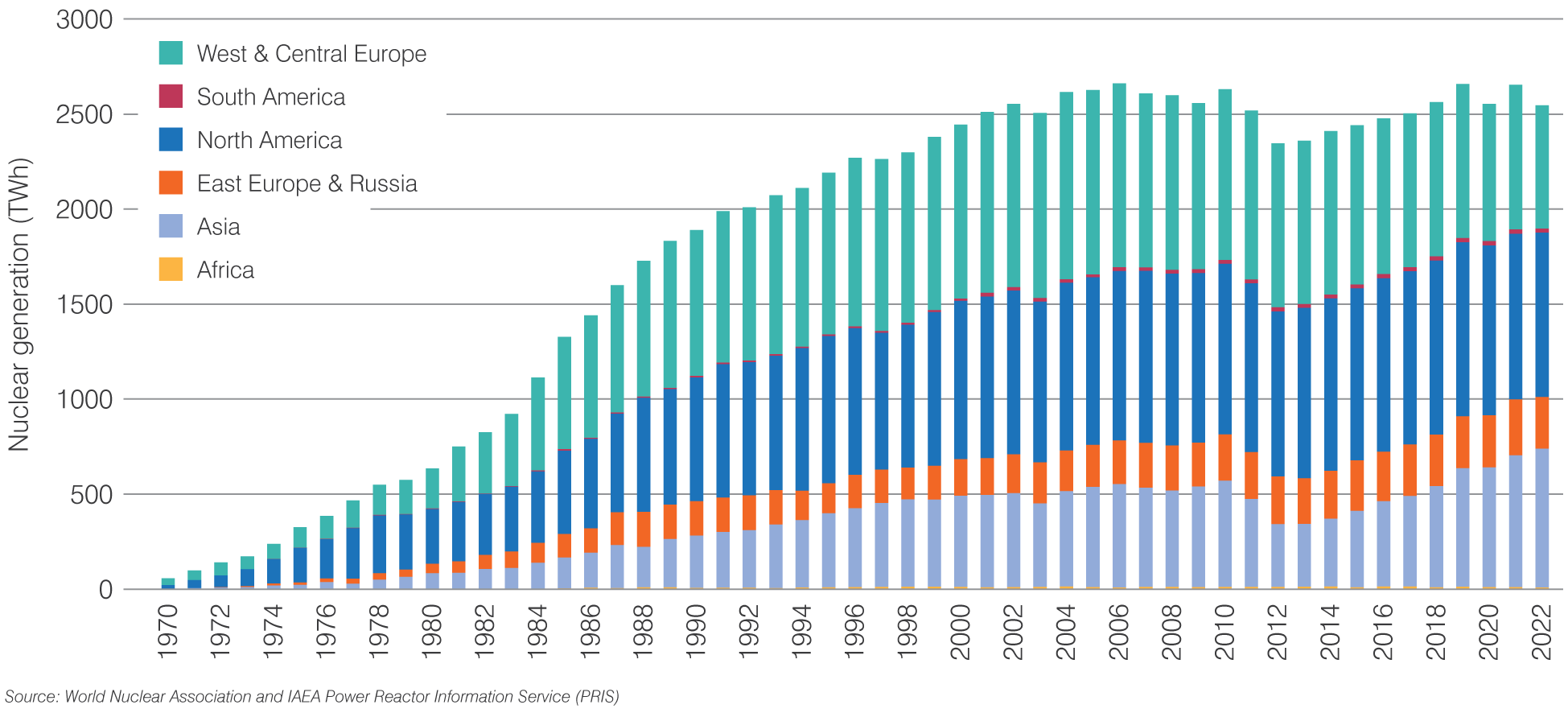
Source: World Nuclear Association and IAEA Power Reactor Information Service
In 2022 nuclear generation increased by 37 TWh in Asia. There were minor decreases in South America and in Africa, but output was still within typical levels for these regions over recent years. Closure of Palisades contributed to the 6 TWh decline in output in North America. Output declined by 22 TWh in East Europe and Russia, a reduction similar to the estimated fall in generation in Ukraine. Generation declined by 112 TWh in West and Central Europe; this reduction can be attributed to the 34 TWh reduction in output in Germany, as reactors closed down, and the 81 TWh reduction in output in France, due to a high number of reactor outages.
Figure 2. Regional generation
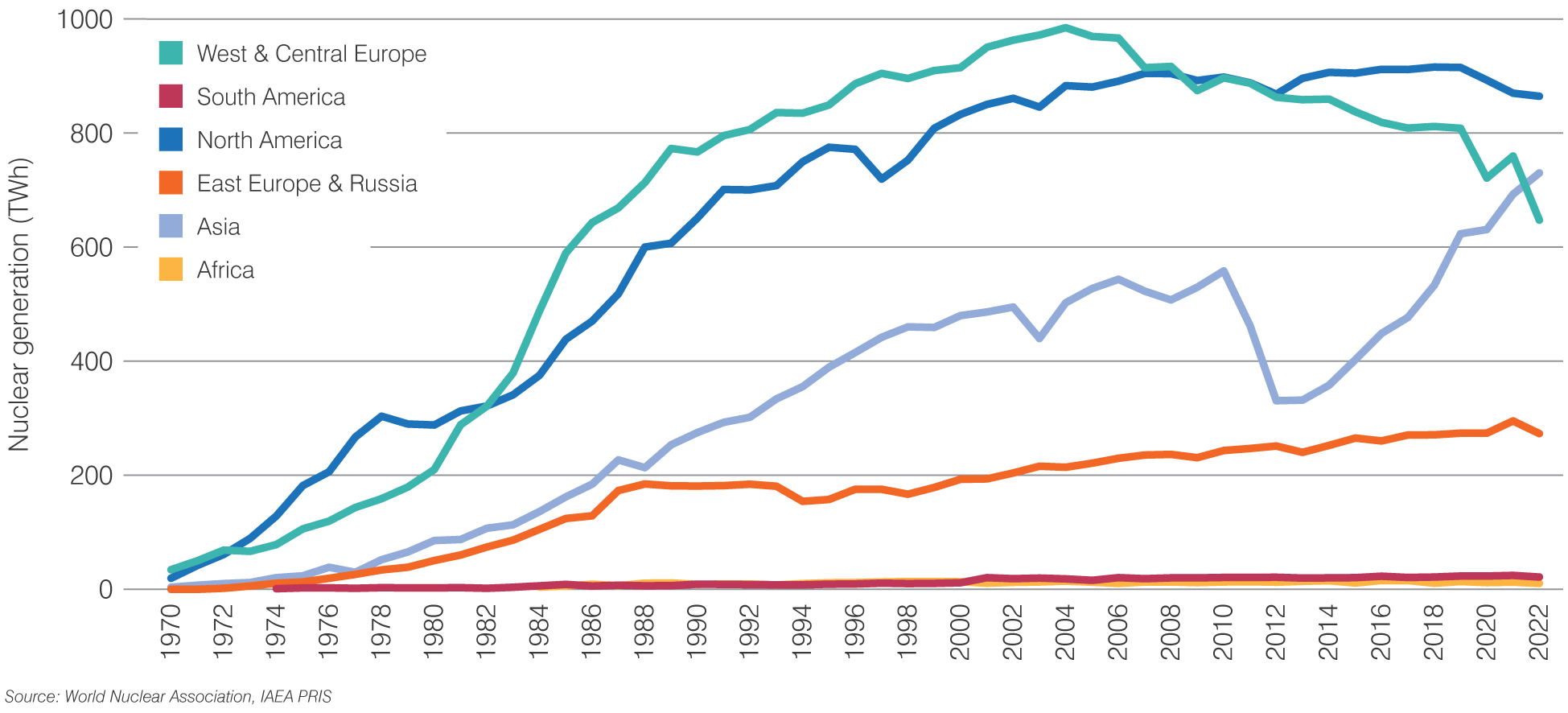
Source: World Nuclear Association and IAEA Power Reactor Information Service
In 2022 the end of year capacity of operable nuclear power plants was 394 GWe, up 5 GWe on 2021. The total capacity of reactors that produced electricity in 2022 was 363 GWe, down 7 GWe from 2021. In most years, a small number of operable reactors do not generate electricity, for example if they are undergoing extended outages. In recent years the figure has been higher, as reactors in Japan await approval to restart following the Fukushima Daiichi accident in 2011.
Figure 3. Nuclear generation operable capacity (net)
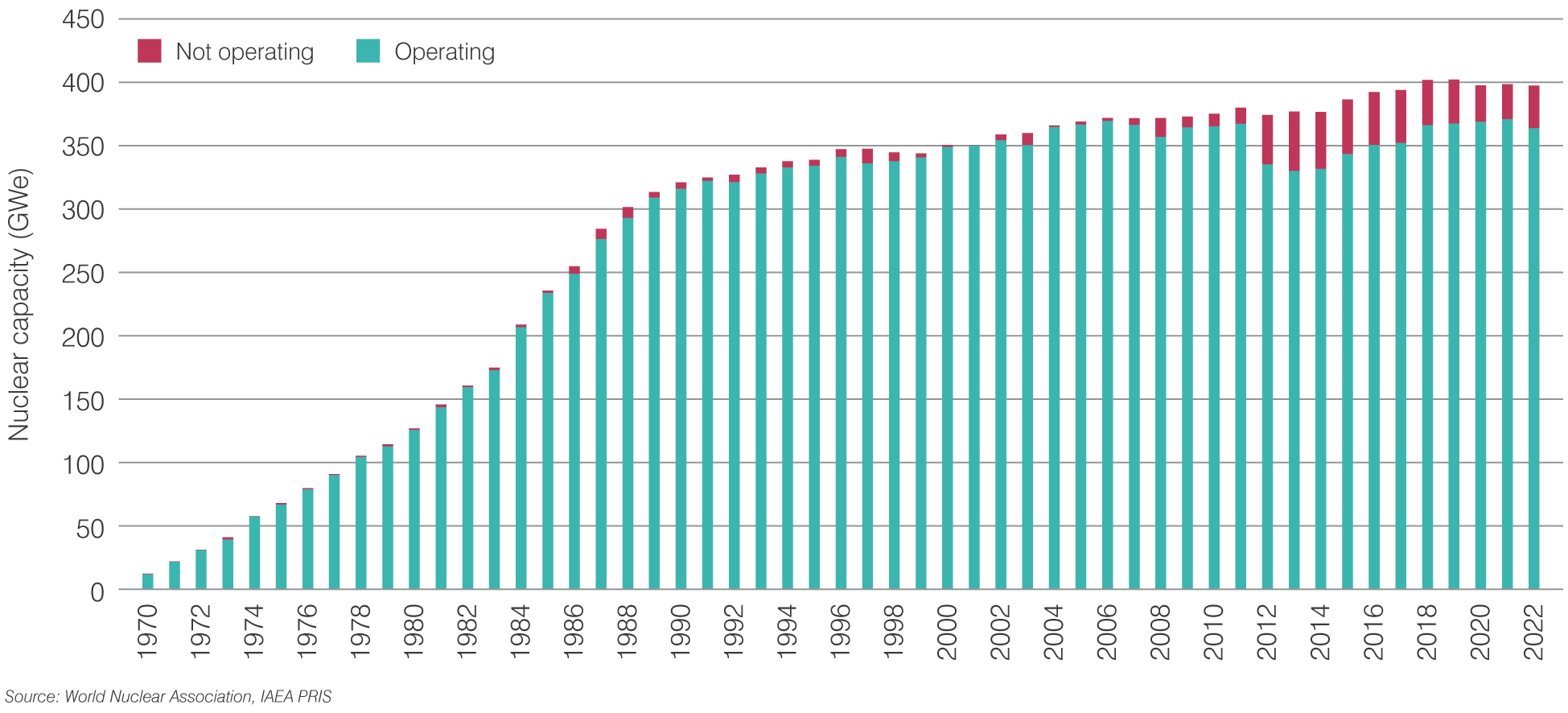
Source: World Nuclear Association, IAEA PRIS
The total number of operable reactors at year-end 2022 was 437, up one from 2021. Just over 70% of all operable reactors are pressurized water reactors (PWRs), with all but two of the 36 reactors that have started up between 2018 and 2022 being PWRs.
Table 1. Operable nuclear power reactors at year-end 2022 (change from 2021)
|
Africa |
Asia |
East Europe & Russia |
North America |
South America |
West & Central Europe |
Total |
|
|
BWR |
20 |
33 |
8 |
61 |
|||
|---|---|---|---|---|---|---|---|
|
FNR |
2 |
2 |
|||||
|
GCR |
8 (-3) |
8 (-3) | |||||
|
HTGR |
1 |
1 |
|||||
|
LWGR |
11 |
11 |
|||||
|
PHWR |
23 |
19 | 3 |
2 |
47 |
||
|
PWR |
2 |
104 (+5) |
40 |
61 (-1) | 2 |
98 |
307 (+4) |
|
Total |
2 |
148 |
53 |
113 | 5 |
116 (-3) |
437 (+1) |
Figure 4 shows total global electricity generation from nuclear power plants by age in each year since 1970. The ages of the reactors generating electricity in each year are indicated by the colours representing those ages in each bar.
The rapid expansion of nuclear generation in the 1970s and '80s is shown by the continued presence of the redder hues in the chart, indicating reactors in their first decade of operation. With the slowing of the pace of new reactor start-ups in the 1990s, the amount of red in each year's bar reduces. With increased construction and subsequent commissioning of reactors in recent years the amount of electricity generated by younger reactors has started to increase again, shown by the increasing amount of red in the bars over the last decade.
Figure 4. Total global nuclear electricity generation by age of reactor
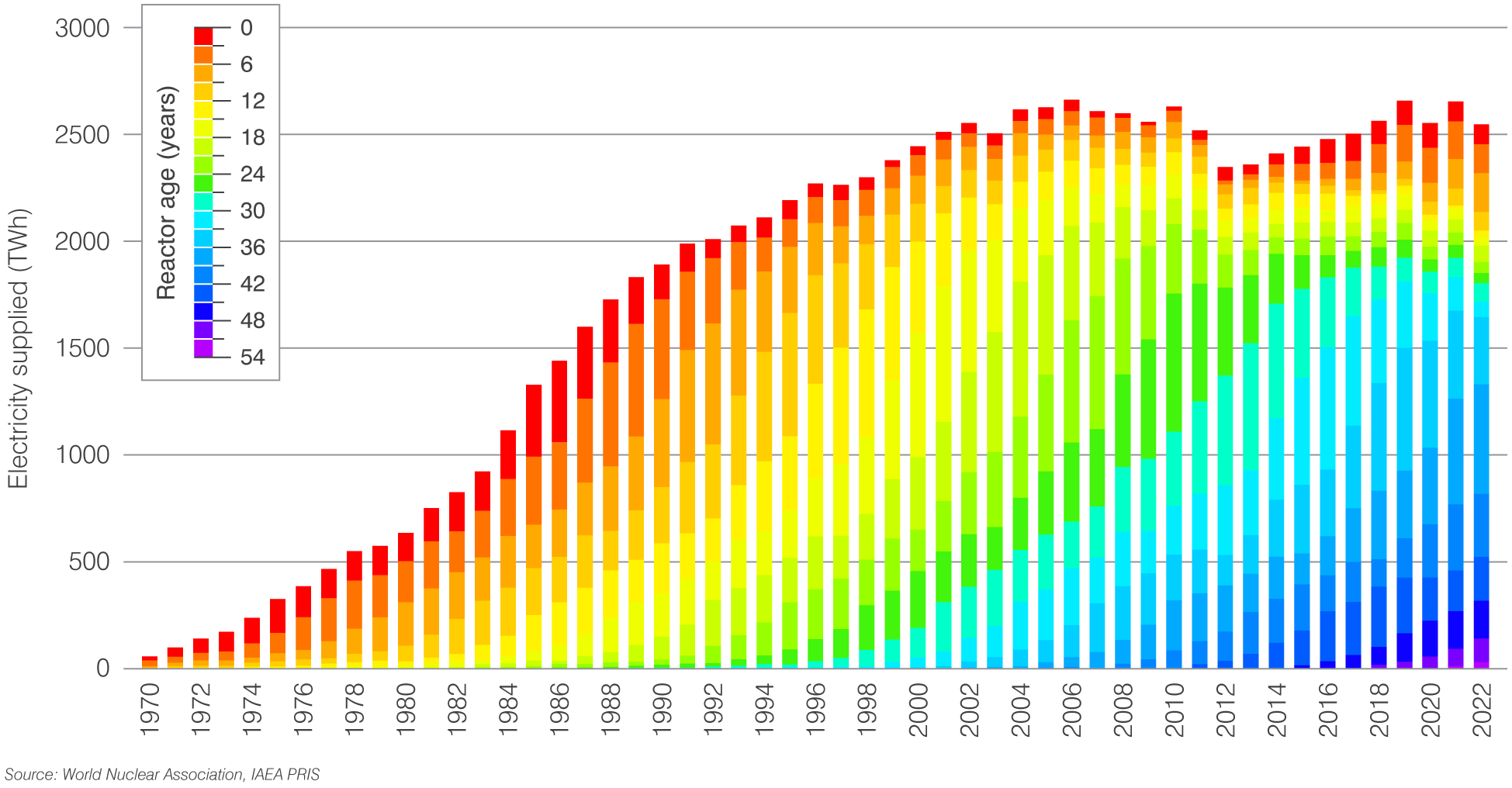
Source: World Nuclear Association, IAEA PRIS
Operational performance
In 2022 the global average capacity factor was 80.5%, down from 82.3% in 2021, but still continuing the trend of high global capacity factors seen since 2000. Capacity factors in this section are based on the performance of those reactors that report electricity generation in any one calendar year.
Figure 5. Global average capacity factor
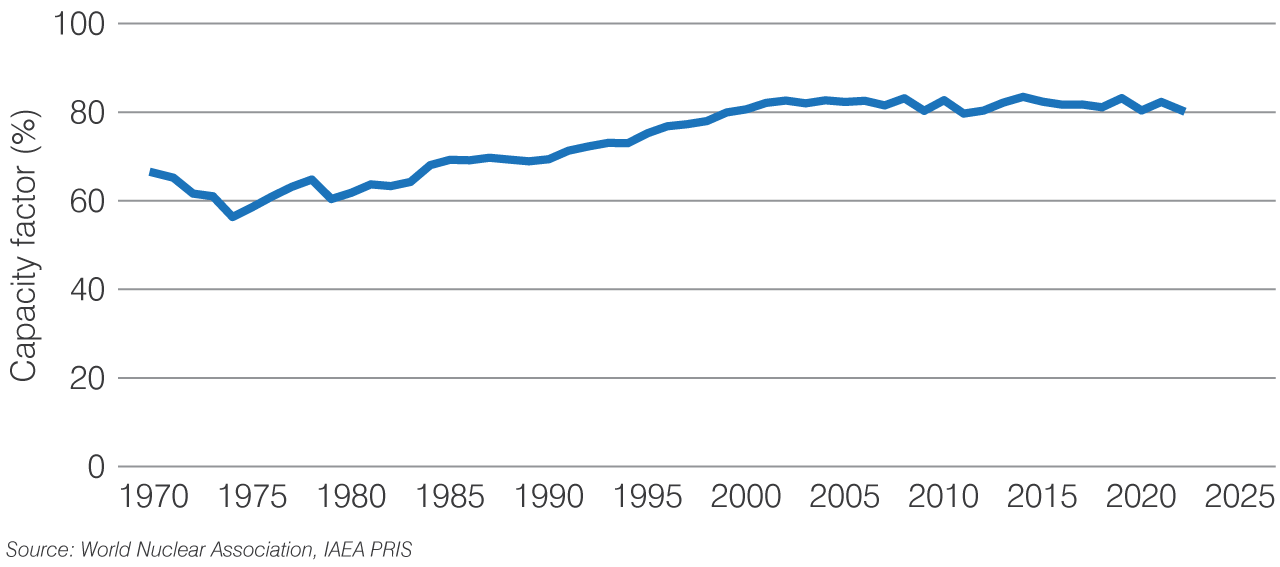
Source: World Nuclear Association, IAEA PRIS
In 2022, capacity factors for different reactor types were broadly consistent with those achieved in the previous five years. On average, BWR reactors achieve the highest capacity factors consistently.
Figure 6. Capacity factor by reactor type
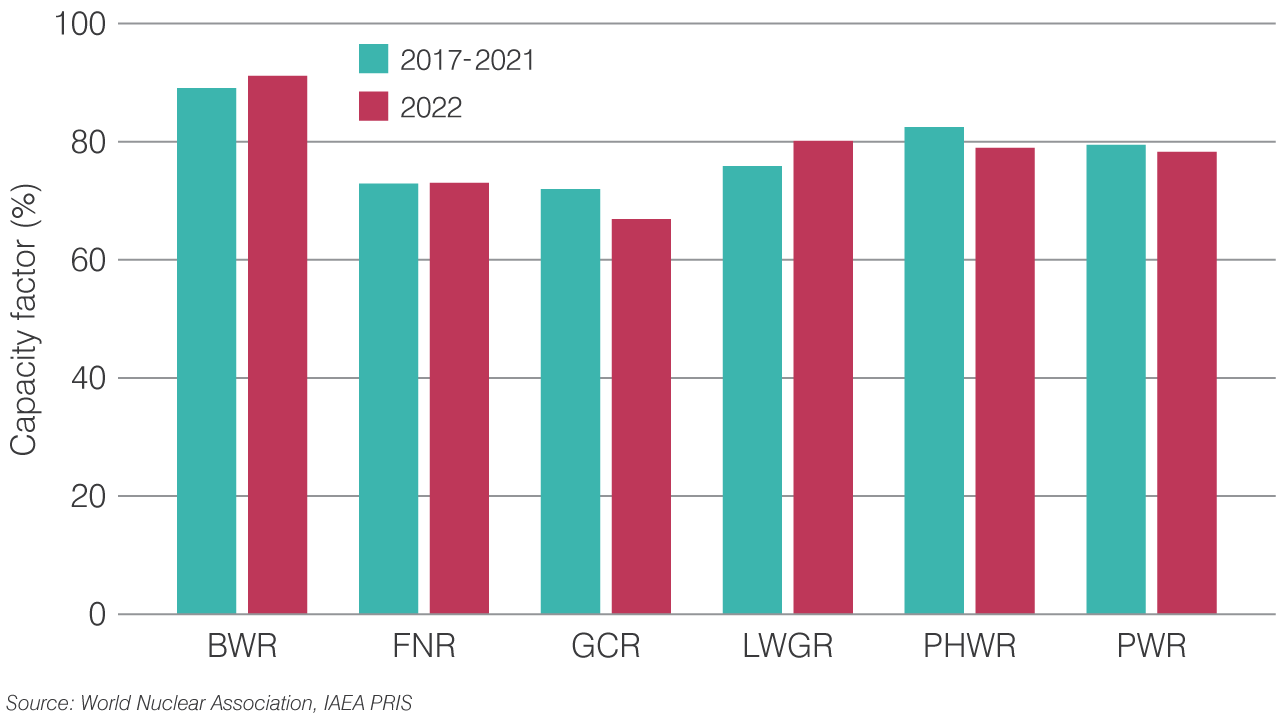
Source: World Nuclear Association, IAEA PRIS
Capacity factors in 2022 for reactors in most geographical regions were also broadly consistent with the average achieved in the previous five years, with North America maintaining the highest average capacity factors. Capacity factors for Africa are determined by the performance of the sole nuclear power plant operating there, South Africa's Koeberg.
Figure 7. Capacity factor by region
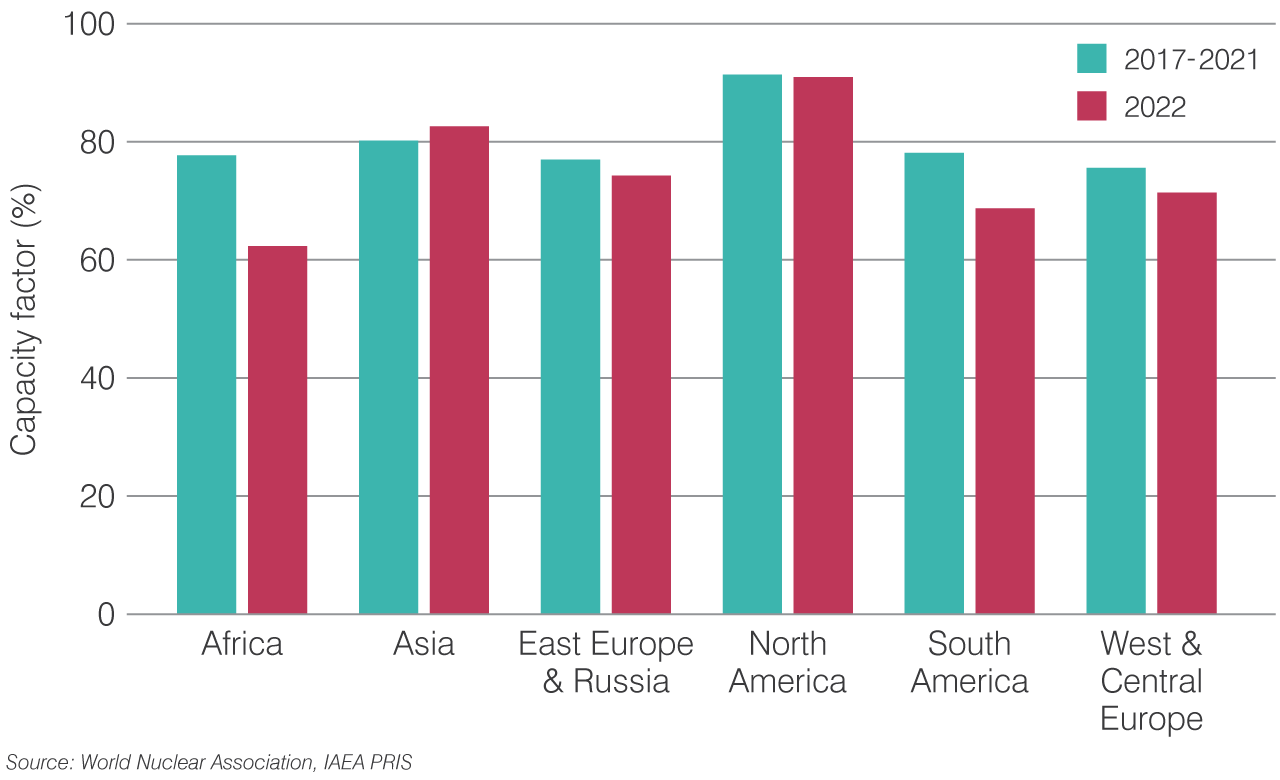
Source: World Nuclear Association, IAEA PRIS
There is no overall age-related decline in nuclear reactor performance, although there is some variation, with lower average capacity factors for those reactors between 25 and 35 years of operation and higher than average capacity factors for those reactors exceeding 45 years of operation.
Figure 8. Mean capacity factor 2018-2022 by age of reactor
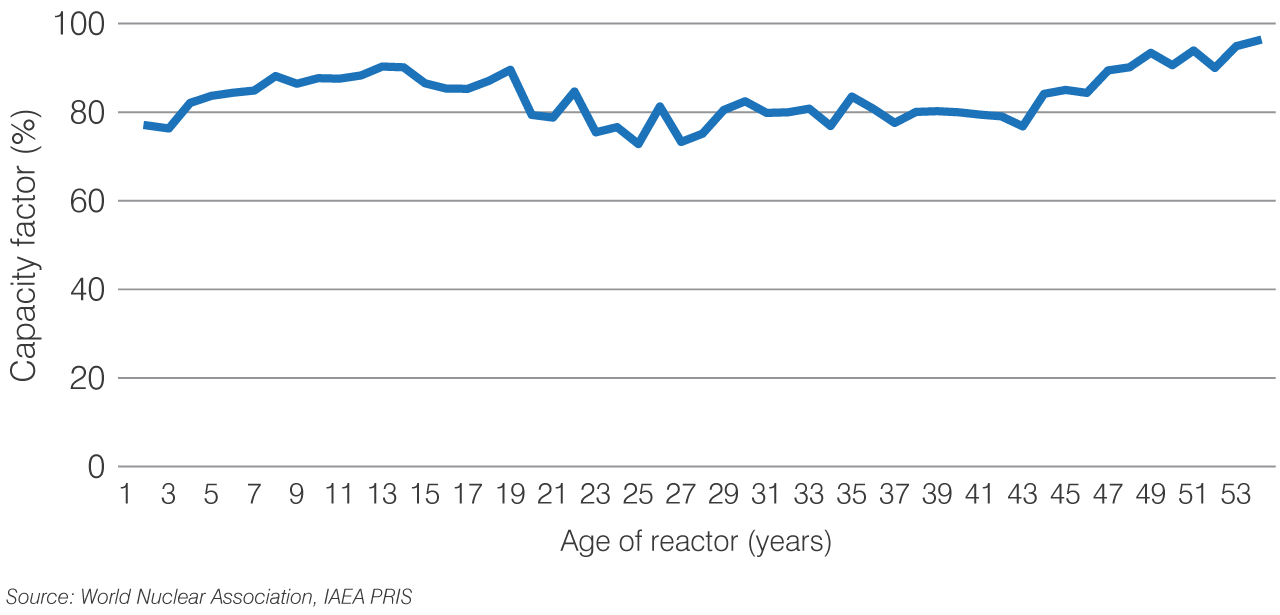
Source: World Nuclear Association, IAEA PRIS
The spread of capacity factors in 2022 is broadly similar to the average of the previous five years. Just over two-thirds of reactors have a capacity factor greater than 85%.
Figure 9. Percentage of units by capacity factor
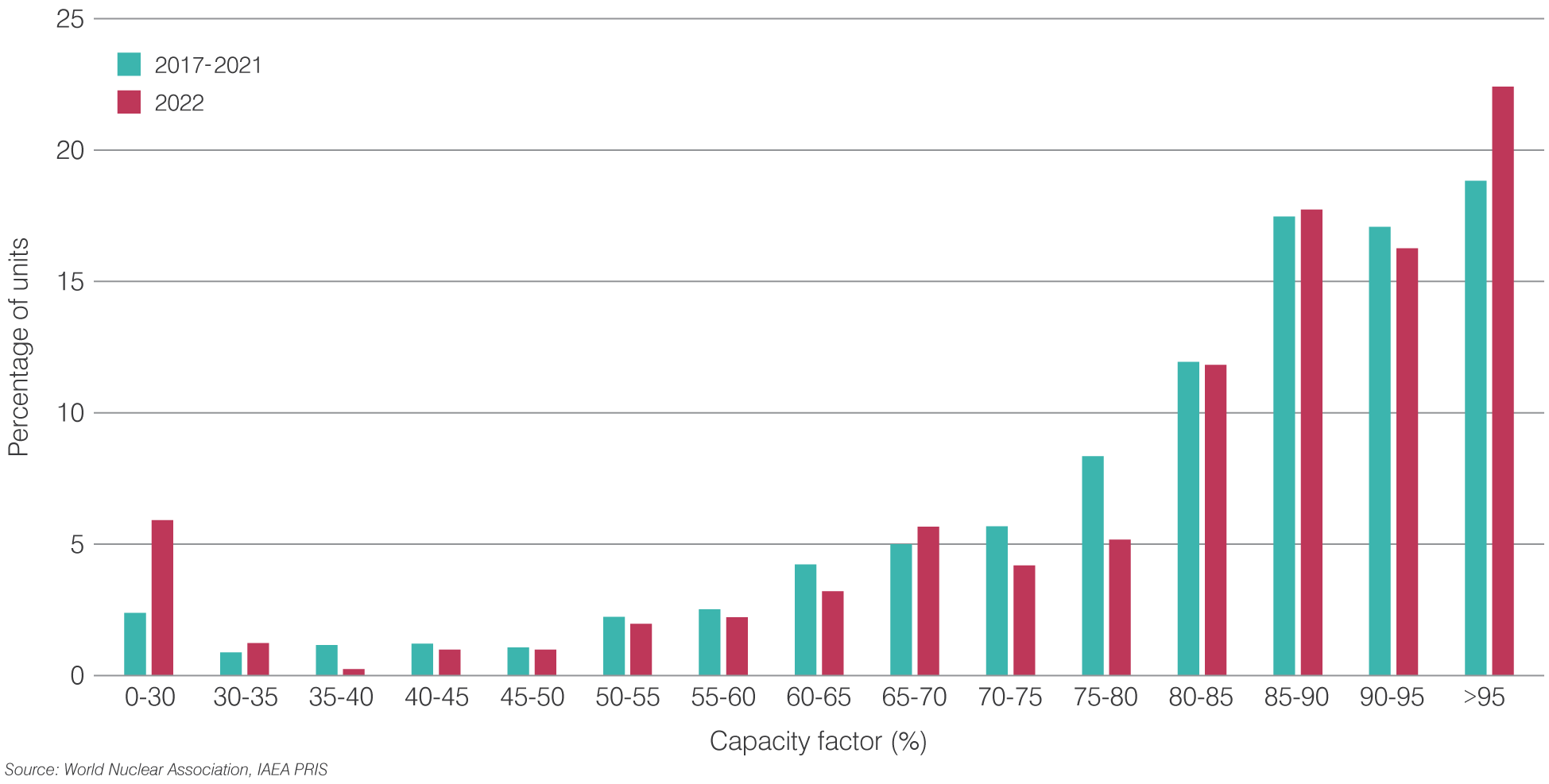
Source: World Nuclear Association, IAEA PRIS
There has been a steady improvement in average capacity factors in each decade since the 1970s. The high capacity factors achieved in the 2010s have continued from 2020 onwards.
Figure 10. Long-term trends in capacity factors
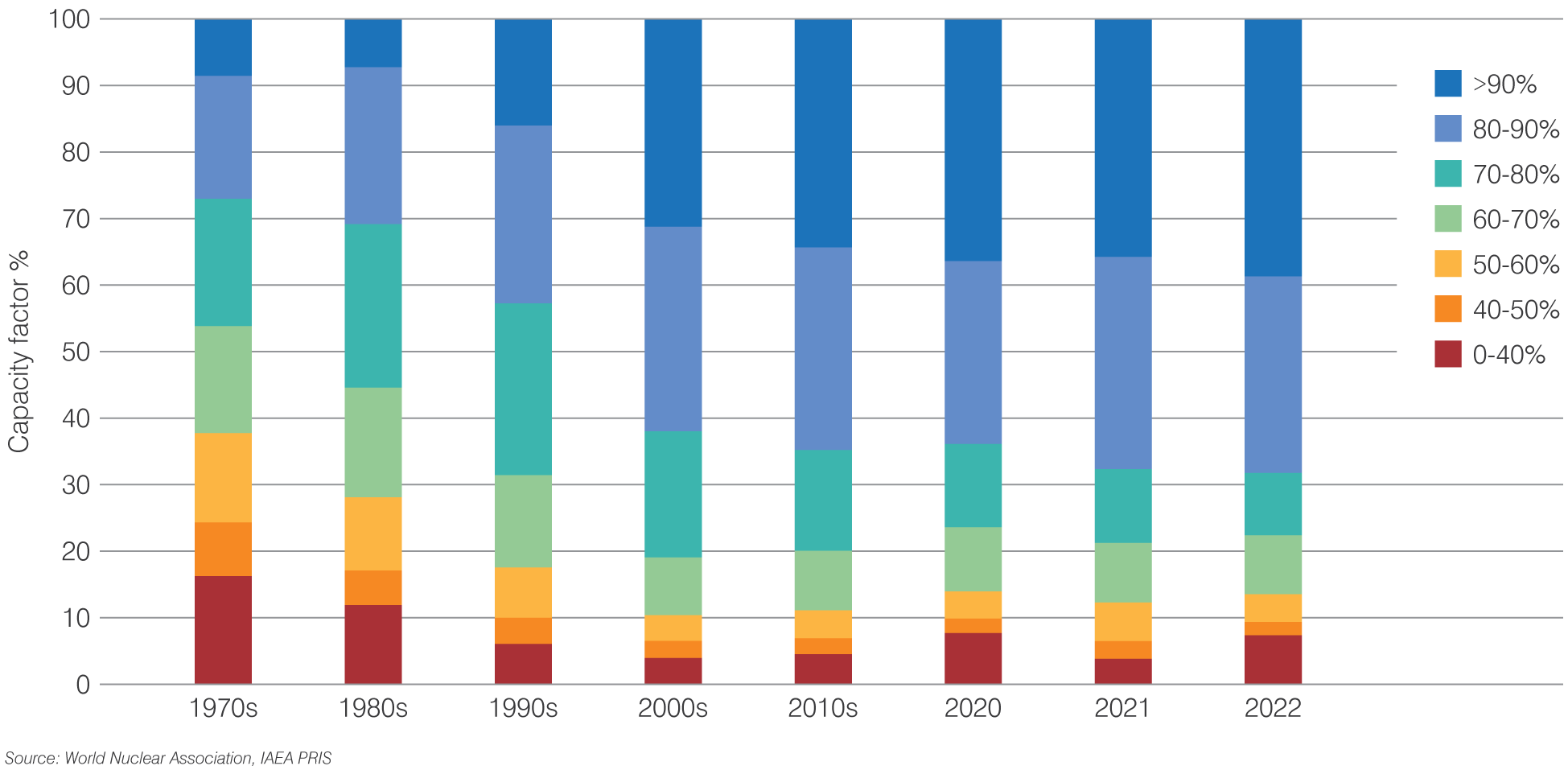
Source: World Nuclear Association, IAEA PRIS
New construction
In 2022 construction began on eight large PWRs. Five reactors commenced construction in China, two at the El Dabaa site in Egypt and one, the fourth unit at Akkuyu, in Turkey.
Table 2. Reactor construction starts in 2022
| Location | Model | Process | Design net capacity (MWe) | Construction start date | |
| Tianwan 8 | China | VVER V-491 | PWR | 1100 | 25 February 2022 |
| Xudabao 4 | China | VVER V-491 | PWR | 1100 | 19 May 2022 |
| Sanmen 3 | China | CAP1000 | PWR | 1163 | 28 June 2022 |
| Haiyang 3 | China | CAP1000 | PWR | 1161 | 7 July 2022 |
| El Dabaa 1 | Egypt | VVER V-529 | PWR | 1100 | 20 July 2022 |
| Akkuyu 4 | Turkey | VVER V-509 | PWR | 1114 | 21 July 2022 |
| Lufang 5 | China | HPR1000 | PWR | 1100 | 8 September 2022 |
| El Dabaa 2 | Egypt | VVER V-529 | PWR | 1100 |
20 November 2022 |
Source: World Nuclear Association, IAEA PRIS
With eight construction starts in 2022, and six reactor connections to the grid, the total number of units under construction at the end of 2022 was 60, two more than at the end of 2021.
Table 3. Units under construction year-end 2022
| BWR | FBR | PHWR | PWR | Total | |
| Argentina | 1 | 1 | |||
| Bangladesh | 2 | 2 | |||
| Belarus | 1 | 1 | |||
| Brazil | 1 | 1 | |||
| China | 2 | 20 | 22 | ||
| Egypt | 2 | 2 | |||
| France | 1 | 1 | |||
| India | 1 | 3 | 4 | 8 | |
| Iran | 1 | 1 | |||
| Japan | 2 | 2 | |||
| Russia | 1 | 2 | 3 | ||
| Slovakia | 2 | 2 | |||
| South Korea | 3 | 3 | |||
| Turkey | 4 | 4 | |||
| Ukraine | 2 | 2 | |||
| United Arab Emirates | 1 | 1 | |||
| United Kingdom | 2 | 2 | |||
| United States of America | 2 | 2 | |||
| Total | 2 | 4 | 3 | 51 | 60 |
Source: World Nuclear Association, IAEA PRIS
Six reactors were connected to the grid for the first time in 2022. This included Olkiluoto 3 in Finland, where construction of the first-of-a-kind EPR began in 2005. Much shorter construction times were achieved for the other five reactors, with construction of the Karachi 3 HPR1000 (Hualong One), in Pakistan, taking just 69 months.
Table 4. Reactor grid connections in 2022
| Location | Design Net Capacity (MWe) | Model | Reactor Type | Construction Start | First Grid Connection | |
|---|---|---|---|---|---|---|
| Olkiluoto 3 | Finland | 1600 | EPR | PWR | 12 August 2005 | 12 March 2022 |
| Shin Hanul 1 | South Korea | 1340 | APR-1400 | PWR | 10 July 2012 | 9 June 2022 |
| Barakah 3 | United Arab Emirates | 1310 | APR-1400 | PWR | 24 September 2014 | 8 October 2022 |
| Hongyanhe 6 | China | 1061 | ACPR-1000 | PWR | 24 July 2015 | 2 May 2022 |
| Fuqing 6 | China | 1075 | HPR1000 | PWR | 22 December 2015 | 1 January 2022 |
| Karachi 3 | Pakistan | 1014 | HPR1000 | PWR | 31 May 2016 | 4 March 2022 |
Source: World Nuclear Association, IAEA PRIS
The shortest construction times were achieved with the construction of PWRs in China and the Chinese-designed HPR1000 reactor at Karachi, Pakistan. This continues recent trends, where series build and the retention of skills through ongoing new build programmes have helped contribute to more rapid construction times. In contrast, the first-of-a-kind construction at Olkiluoto 3 took an exceptional 199 months.
Figure 11. Construction times of new units grid-connected in 2022
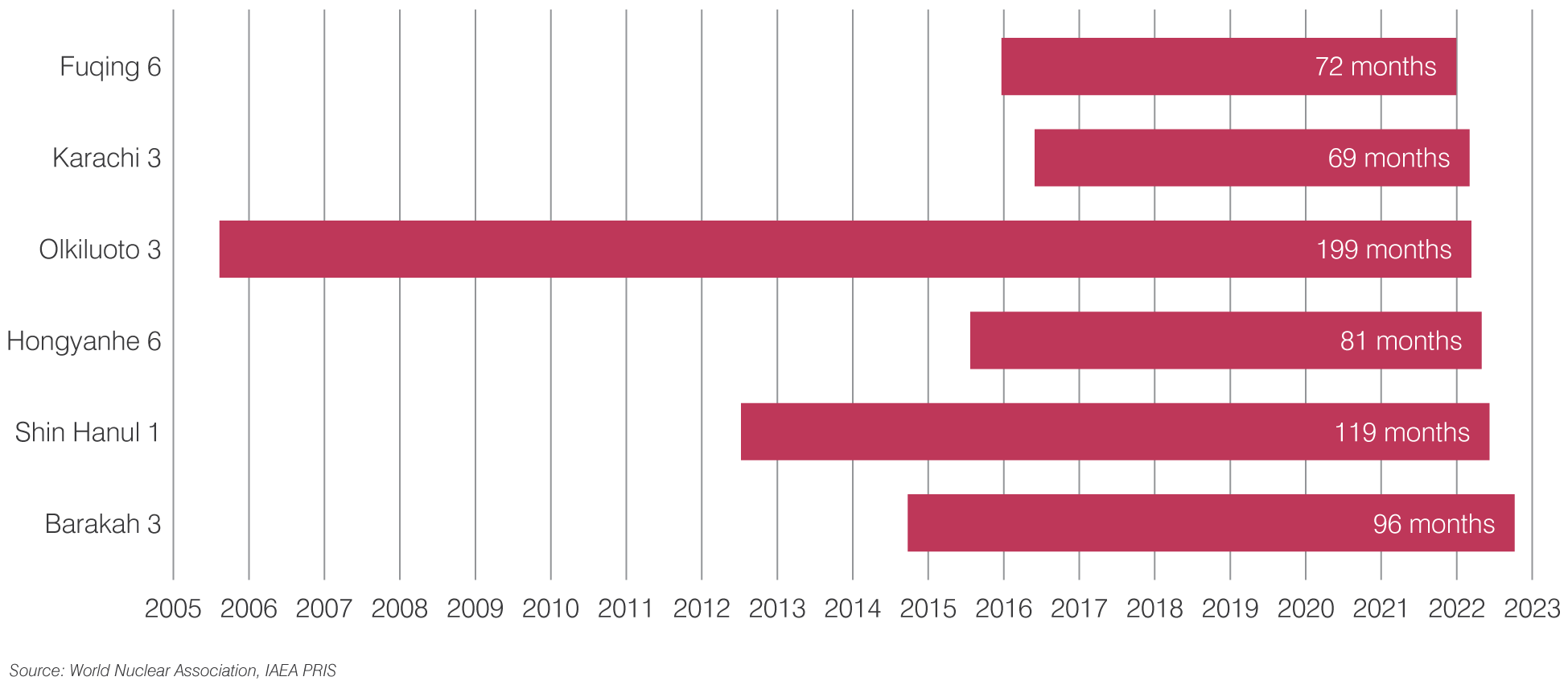
Source: World Nuclear Association, IAEA PRIS
Despite the large variation in reactor construction times, the median construction time for reactors grid-connected in 2022 was little changed from that in 2021, being one month longer, at 89 months.
Most reactors under construction today started construction in the last ten years. The small number that have taken longer are either pilot plants, first-of-a-kind (FOAK) reactors, or projects where construction was suspended before being restarted. Construction on Khmelnitski 3&4, Ukraine, started in 1986 and 1987, respectively, but there has been no active progress since construction was halted in 1990. Mochovce 4, in Slovakia, started construction in 1987, as did Mochovce 3, its sister unit. Mochovce 3 was grid-connected in January 2023.
Figure 12. Operational status of reactors with construction starts since 1983 as of 1 January 2023
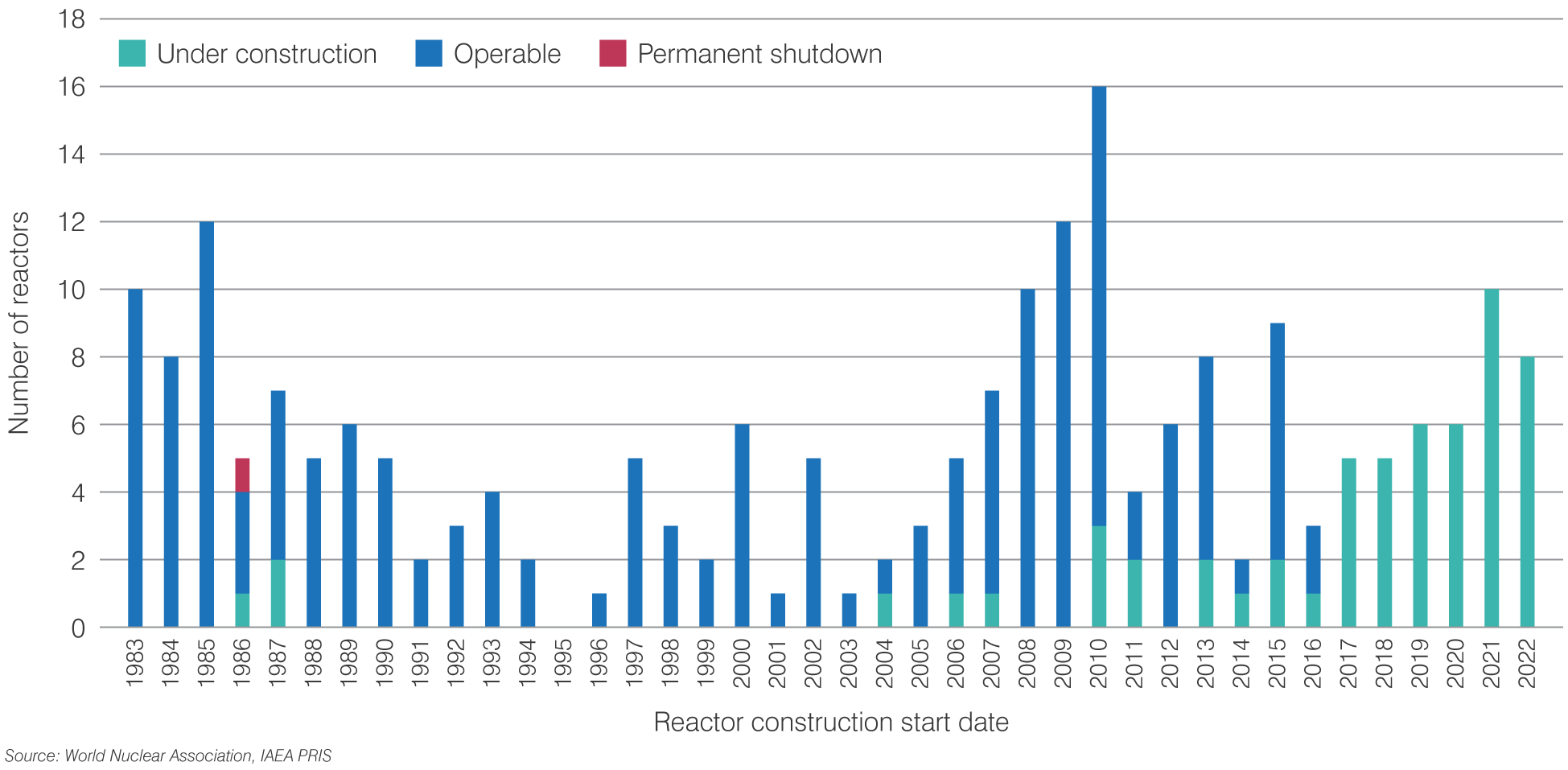
Source: World Nuclear Association, IAEA PRIS
Five reactors were permanently shut down in 2022. The operation of the last three reactors in Germany, which were due to close in 2022 was extended, but all three plants finally closed in April 2023.
Table 5. Shutdown reactors in 2022
In 2022 the five reactors that were permanently shut down had a combined capacity of 3271 MWe.
| Reactor Name | Location | Reference Unit Power (MWe) | First Grid Connection | Permanent Shutdown |
|---|---|---|---|---|
| Hunterston B2 | UK | 495 | 31 March 1977 | 7 January 2022 |
| Palisades | USA | 805 | 31 December 1971 | 20 May 2022 |
| Hinkley Point B2 | UK | 480 | 5 February 1976 | 6 July 2022 |
| Hinkley Point B1 | UK | 485 | 1976-10-30 | 1 August 2022 |
| Doel 3 | Belgium | 1006 | 1982-06-23 | 23 September 2022 |
With the start-up of six reactors and permanent shutdown of five, more reactors started operation than ceased operation for the first time in four years.
Figure 13. Reactor first grid connection and shutdown 1954-2022
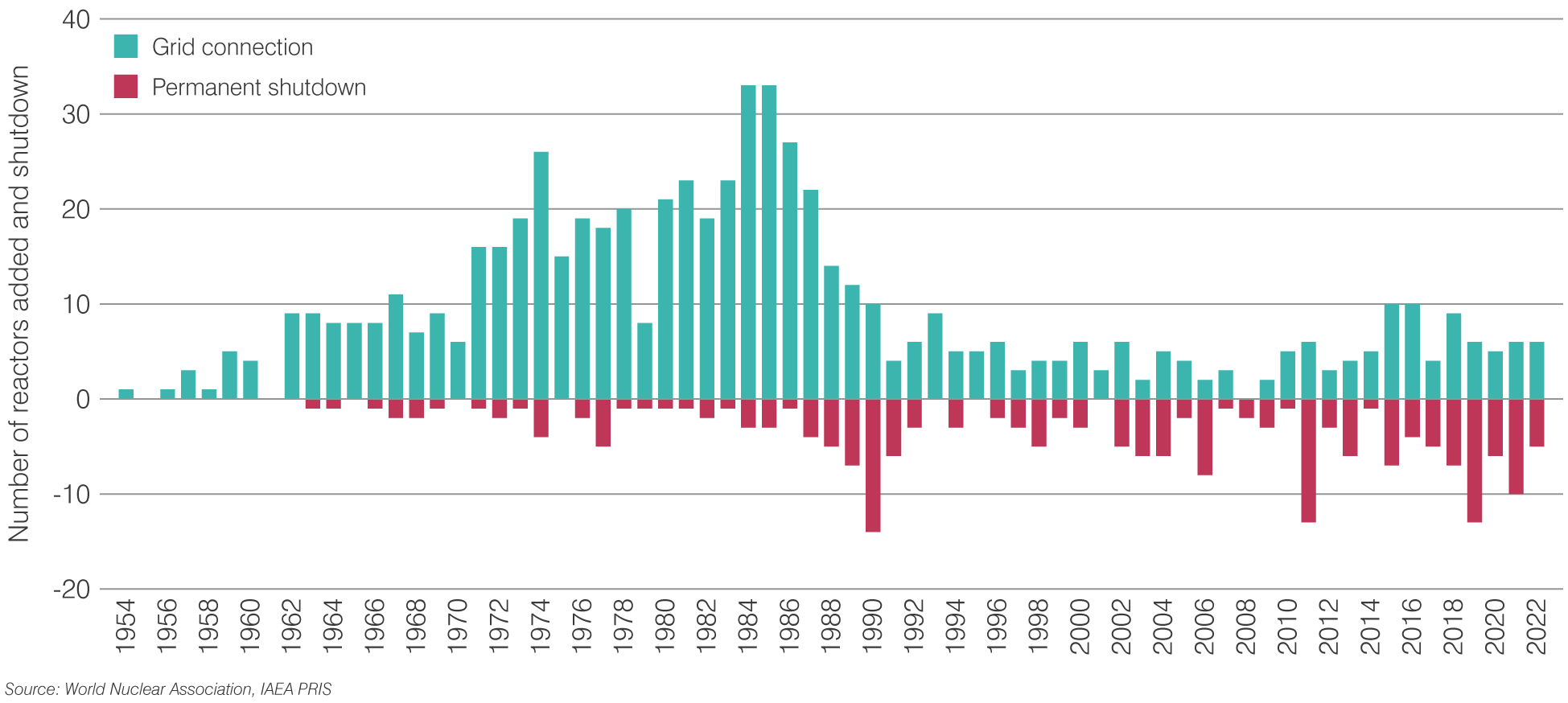
Source: World Nuclear Association, IAEA PRIS